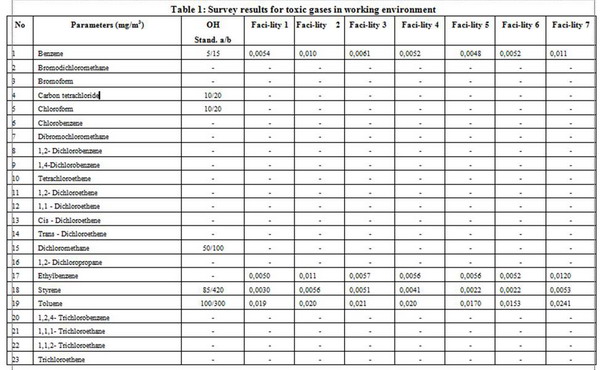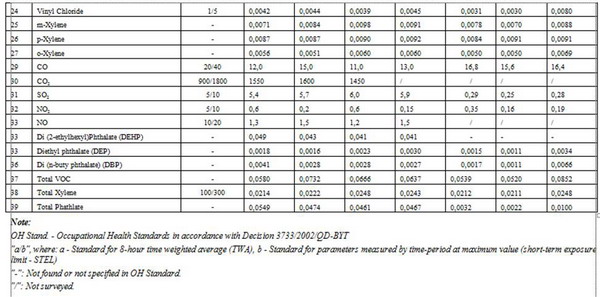Working environment and health situation of plastic recycling workers in Southern Vietnam
1. Research subject and methodology
1.1. Research subject and scope
– Toxic gases in the working environment of 7 plastic and plastic materials manufacturing enterprises (mainly packaging plastics such as LDPE, HDPE and PP) in Ho Chi Minh City and Long An province.
– Workers: 40 workers (34 males and 6 females) at 4 plastic recycling enterprises.
2.2. Research methods and techniques applied
The study was conducted according to the descriptive cross-cutting method.
2. Results and discussion
2.1. Surveyed results of toxic gases in working environment
Toxic gases investigated in working environment include conventional gases and some toxic gases specific to plastics industry. The survey of toxic gases was conducted on a large scale with multiple parameters in order to screen common toxic gases in plastic facilities and then divided into 3 major groups of substances which are VOCs, conventional gases and toxic additives used in plastic industry dispersed into the environment. The results are shown in Table 1.


The results show that:
– At the pre-heating stage to transfer plastic to the molten state, plastic film coating processes etc., usually arouse plastic smell mixed with the smell of some volatile organic compounds (VOCs). The survey results of VOCs emissions in these areas show that the composition of the VOC includes different substances. Among 27 VOCs surveyed in a number of plastic recycling facilities, the most common and specific compounds in plastic facilities (including full plastic recycling and plastic recycling as a part of the manufacturing process) are solvent vapors such as Benzene, Toluene, Styrene, Xylene, Vinyl chloride, etc., however, all concentrations are much lower than the OH standards stipulated in Decision No 3733/2002/QD-BYT [5].
– Toxic gases such as CO, NOx, SO2 are required to be monitored in many industries because of their major dispersion in working environment. Compared with the monitoring results observed in many other industries such as paper production, rubber production, etc., the measured concentrations are within the limits allowed by the OH standards stipulated in Decision No 3733/2002/QD-BYT, similar to this survey results.
– For specific additives used in the plastic industry, this is one of very few studies that have examined the composition of the additives used in the plastic industry which emit into the air. The plastic industry uses many different additives including Phthalates group commonly used to increase the hardness, toughness and transparency of plastic. However, these substances are the agents that could cause hormonal disturbances, a current topic of interest for studies in the world [4].
In this study, some subtances of the Phthalate Ester group were surveyed. Although in current Vietnamese standards there are only allowable values for Dibutyl Phthalate measured in 8-hours of work at 2 mg/m3, measured in a random case at 4 mg/m3 (not surveyed in this study), taking US-OSHA documents as reference, the proposed occupational exposure limits for DEHP, DBP in the working environment are at 5 ppm [1]. Thus, the surveyed concentrations of Phthalate Esters in the working environment of plastic facilities still meet allowable standards.

Comments and discussion:
As can be seen, the compositions of VOCs emissions in partial plastic recycling area of large plastic facilities as well as in small and medium full plastic recycling facilities are the same, including the solvent vapors of Benzene, Toluene, Styrene, Xylene, Vinyl chloride, and that their emission levels are similar at the time of measurement.
However, the levels of Phthalates emissions into the air are apparently different. Compared to mean values, it could be seen that the total Phthalates concentration (including DEHP, DEP and DBP) in full plastic recycling facilities is 9.6 times higher than the total Phthalates concentration in areas that have plastic recycling as a part of manufacturing processes in large plastic facilities.
In addition, there is a notable difference in the concentrations of DEHP emission: in the large plastic facilities having partial plastic recycling, the DEHP emission was not detected in the air of working environment, but its concentration among 3 Phthalates investigated at full plastic recycling facilities was of the highest.
2.2. Health examination results of plastic recycling workers
The total number of examined workers is 40 including 31 males, 6 females and 3 incomplete examination records. Thus, statistics on the workers’ health was based on complete examination records.
The health examination results of plastic recycling workers showed that the proportion of workers having eye diseases is very high, accounting for 43.25% of the examined workers. Existing survey data is not really adequate to conclude or make assumptions about the relationship between the working environment and high eye diseases (accounting for nearly a half of examined workers). However, the survey of this research has identified in many plastic recycling facilities that the working environment is quite dark with low lighting intensity, much lower than OH standards. This could be one of the reasons contributing to the increase of eye problems for plastic recycling workers.
In addition to eye diseases, some workers have lumbar-hip syndrome, nerve pain and osteoarthritis pain, accounting for 18.92%, which also need attention. As shown in the survey, workers have to transport manually by hand or shoulder bags of recycled plastic beads weighing 30-50kg to warehouses or on the delivery vehicles without weight reduction means. This daily work could be one of the reasons causing lumbar-hip syndrome, nerve pain and osteoarthritis pain for workers.
The number of workers suffering from internal medicine diseases (stomach, duodenum, urinary, etc.) accounted for a total rate of 13.51%. According to previous studies by the same group of authors on evaluation of microclimate conditions at plastic recycling facilities in the South [6], the remarkably high temperature factor in the working environment has affected significantly the workers’ heat sensation and hot working condition may be one of the causes contributing to the increased rate of those diseases. According to the Occupational Health documents (Prof. Dr. Hoang Van Binh), the hot working conditions in industrial plants may be an additional factor causing some diseases for workers, such as kidney disease, urinary and gastrointestinal diseases [2].
The results of workers’ general health examination have also showed some risks in the workplace that could cause occupational diseases, such as noise exceeding the allowable level in materials grinding area, whereas 100% of workers in small and medium plastic recycling facilities do not wear anti-noise buttons; or high levels of dust may cause respiratory diseases, etc. The study has conducted a survey of deafness, hearing and respiratory function of workers through clinical examination. The results have showed that 100% of plastic recycling workers had normal respiratory function and their hearing not adversely affected. Previously, in Pham Thi Bich Ngan et al.’s study (1994), up to 75% of the examined workers in plastic industry had respiratory morbidity. According to this survey results, 15 out of 24 workers examined had abnormal respiratory function, in which 2 workers had mixture syndrome, 5 congestion syndrome and 8 upper limit syndrome [3]. Thus, the preliminary results of study showed that currently, workers in the plastic recycling facilities have not been adversely affected in respiratory function and hearing.
3. Conclusion
3.1. There are no convincing evidences of the effects of toxic gases and additives dispersing in working environment on workers’ health in plastic recycling facilities.
– The compositions of VOC emissions in partial plastic recycling areas of the large plastic facilities as well as in small and medium full plastic recycling facilities are the same, including the solvent vapors of Benzene, Toluene, Styrene, Xylene, Vinyl chloride and their emission levels are similar at the time of measurement and still within the limits allowed by the OH standards stipulated in Decision No 3733/2002/QD-BYT.
– The total Phthalates concentration in average (including DEHP, DEP and DBP) in full plastic recycling facilities is 9.6 times higher than the total Phthalates concentration in areas having plastic recycling process as part of manufacturing processes in large plastic facilities. Currently there is no hygiene standard for these parameters in Vietnam. However, the measured concentrations are lower than required in the United States (5 ppm).
– The common toxic gases such as CO, SO2, NOx have concentrations within the limits allowed by the OH standards stipulated in Decision No 3733/2002/QD-BYT.
3.2. Some diseases having high percentage may be due to other factors in the working environment such as low lighting, poor ventilation, extreme temperature and poor posture at work.
Reference
- https://www.osha.gov/dts/chemicalsampling/data/CH_235200.html
- Prof. Dr. Hoang Van Binh. Occupational Health. Scientific and Technical Publishing House (2010).
- Pham Thi Bich Ngan. To study the effects of working conditions to workers at plastic industry in Ho Chi Minh City. To propose solutions to improve working conditions, limit environmental pollution, protect workers’ health, prevent occupational accidents and diseases for workers (1994).
- WHO/PCS/EDC/02.2. Global assessment of the state-of-the-science of endocrine disruptors.
- Decision No 3733/2002/QN-BYT of Ministry of Health (2002).
- Ngo Thi Mai. Assessment of the combined effects of microclimate on workers’ heat feeling in some plastic facilities in the South. Journal of Safety – Health and Working environment. Number 4,5 & 6 (2013).
MSc. Ngo Thi Mai et al., National Institute of Labour Protection
(Source: nilp.vn)
